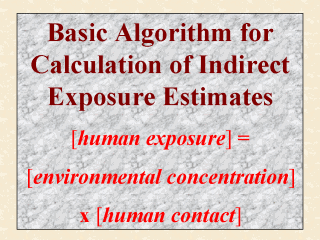| front |1 |2 |3 |4 |5 |6 |7 |8 |9 |10 |11 |12 |13 |14 |15 |16 |17 |18 |19 |20 |21 |22 |23 |24 |review |
 |
Almost all
indirect measurement methods (IMM) available today are built upon the well-received, but
not fully validated, premise or basic algorithm that exposure to environmental contaminant
is the product (interaction) of human contact and environmental concentration. To a great
extent, the reverse implication of this premise is always true. That is, no human exposure
would occur if there were no human contact with the contaminant. Nor would there be any
human exposure to the contaminant if the latter were not found or available in the
personís environment. The problem with the above premise is that both the terms human contact and environmental concentration are very difficult to define and measure. Environmental concentration is not only source-dependent; it is also a temporal and spatial variable. Strictly speaking, environmental concentration for a specific space and time period can only be approximated at best. Human contact is both a human behavioral and a physicochemical variable, which is even harder to define or quantify. For example, inhalation exposure is a function of a person's inhalation rate and the concentration of the chemical in the person's breathing zone. Yet inhalation rate is not only gender- and age-specific, but also a function of human activity. In the several slides that follow, the various forms of human contact and of environmental concentration were discussed separately, largely by means of the same four hypothetical exposure cases presented in the last lecture. |